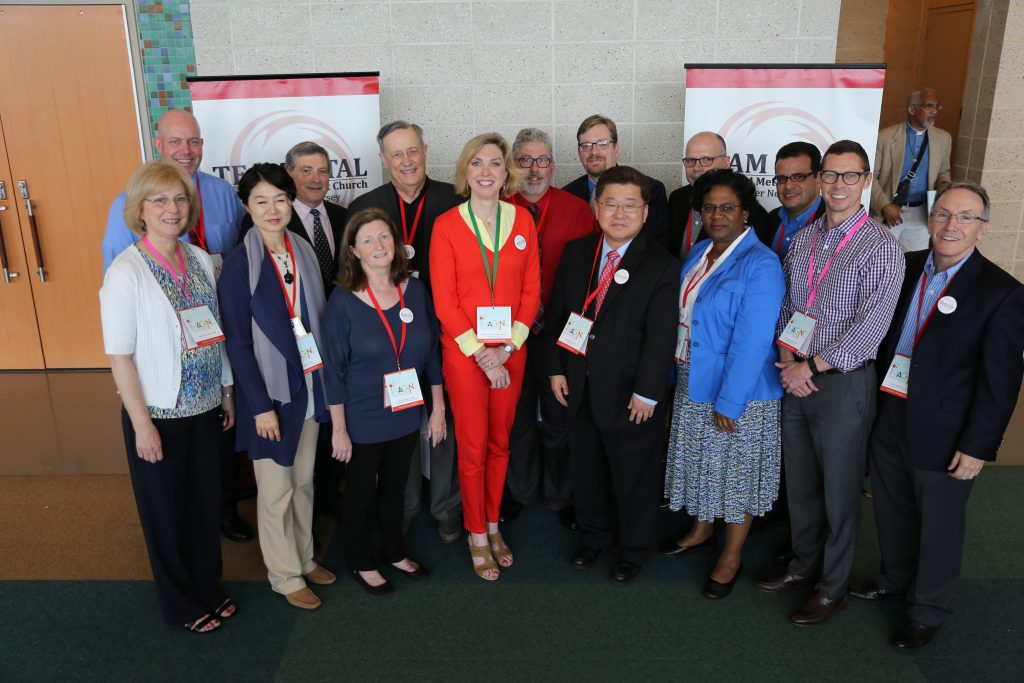Admittedly, Team Vital involvement is an intensive and thorough experience.
As Eric Drew, Greater New Jersey Director of Worship and a Team Vital facilitator, says, “Every month I’m working with one church or another to get through challenges and obstacles to vitality. That’s a reality for any organization in our quickly changing world. But each month I also see many celebrations of progress and vitality growth.”
That “vitality growth” is just what Team Vital is all about.
Session 1 of the process focuses on intense learning about the church community and the five markers of church vitality (worship, small groups, new disciples, missions and stewardship). Churches also perform gap assessments to evaluate which areas are in need of improvement, and to go about prioritizing the steps of their action plans.
Session 2 shifts the focus to a discussion about changing church culture, buy-in and communication as churches concentrate on developing Strategic Action Plans for their ministry. For meaningful change and increases in vitality to take place, communication and implementation are critical pieces of the puzzle. The Strategic Action Plan equips churches with the practical tools and timeline for that kind of effective communication and implementation to take place.
Drew describes the Team Vital process this way: “There is so much to take in. But as we shift our time towards the right people who need to help us move forward, churches are really able to see great possibilities through Team Vital.”
As of May, 2016, a year in from the launch of Team Vital, 55 GNJ churches have joined. The original pilot group of Team Vital churches is beginning to witness those great possibilities for themselves. In June, churches will meet for their second six-month check-in since the program’s launch in May 2015, where they will share the concrete changes and progress they’ve seen in their churches’ vitality.
Churches will discuss their progress toward vitality as recorded quantitatively with VitalSigns, a significant and meaningful measure of growth. But as important as quantitative data can be, says Rev. Beth Caulfield, Director of Small Groups, numbers alone are not enough to tell the story of churches’ ministry.
“In the end,” explains Caulfield, “our focus is on measuring Team Vital’s success in growing the church and making disciples through changed lives, changed hearts, changed minds. And that is not captured through quantitative data alone. The anecdotal information that is shared is also crucial.”
Caulfield says stories are coming in from participating churches that reflect new and exciting ways of doing ministry. For example, churches are developing new plans for worship to better reflect the worship styles of their communities. They are becoming creative in finding ways to engage and attract new people to small groups and mission. People are becoming more comfortable with stewardship discussions and ways of making disciples.
An important goal of Team Vital is to gather and document these experiences so that church communities can learn from one another.
Currently, the Team Vital Project and Planning Teams are in the process of creating an easily accessible system to analyze what Caulfield terms “bright spots, where new areas of ministry are developing, to see what’s working and why it’s working.”
Rev. Bernie Khaw, a Team Vital facilitator and pastor of Thiells UMC in Thiells, NY, chimes in with his thoughts about evaluating progress in ministry.
“Before I answered my call into the ministry, I worked in the research division of a manufacturing company. As a chemical engineer, I used to tease the research chemists that without engineers all their ideas would not become products. Of course, both were needed for the company to be successful,” says Khaw. “Similarly, the church needs both the ideas and the practical work in order to be successful. Team Vital has given us a ‘methodical’ way to put our ideas into action to produce fruit of the Spirit.”
“Sometimes,” Caulfield says, “churches have done strategic planning before, but those plans often ended up stuck in a file somewhere, never to see the light of day again after a lot of work has been put into them.”
Team Vital changes all of that.
Implementing the strategic plans and witnessing the fruitfulness of Team Vital is part of what makes the process so transformative, both for churches and facilitators.
“Team Vital’s plan,” says Caulfield, “is an action plan: you receive resourcing to continue to meet your goals, and we work as accountability partners to one another.”
For Rev. Derrick Doherty, a Team Vital facilitator and pastor at Middletown UMC, Team Vital has served as an effective way for his community to communicate openly about their ministry goals.
Doherty says, “Team Vital has given us the avenue to discuss and make progress towards our vitality. With Team Vital we have been able to have fruitful conversations and have developed detailed plans, and we are looking forward to implementing [them] and experiencing the fruit.”
“Partnering with each church as a facilitator,” says Drew, “I get to see the importance of connecting with the influencers and committees to move Ministry Action Plans forward. As churches focus on the right schedule, the right first steps, and the right people to help, it is fun for me to see everything line up and imagine the great things that are to come.”
More Team Vital sessions are planned for the future as program momentum builds and more churches join. For more information, please go to: https://www.gnjumc.org/team-vital/

